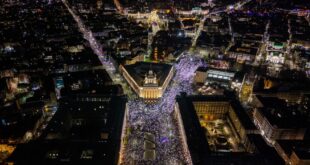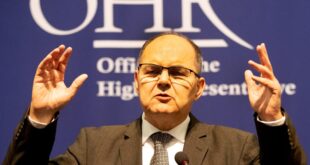 BELGRADEÂ – Smoke billowed from the American embassy in Belgrade after scores of protesters broke into the building on Thursday, cheered on by crowds outside, in a protest at U.S. support for Kosovo’s independence.
BELGRADEÂ – Smoke billowed from the American embassy in Belgrade after scores of protesters broke into the building on Thursday, cheered on by crowds outside, in a protest at U.S. support for Kosovo’s independence.
One protester climbed up to the first floor of the building, located on one of the Serbian capital’s main boulevards, ripped the Stars and Stripes off its pole and briefly put up a Serbian flag in its place.
Protesters jumped up and down on the embassy balcony, holding up a Serbian flag as the crowd below of about 1,000 people cheered them on, shouting “Serbia, Serbia”.
Some 200 riot police finally arrived about half an hour later, beating and arresting some of the rioters and driving the rest away. Some protesters sat on the ground, bleeding.
The storming of the building came during a largely peaceful state-backed rally attended by around 200,000 people to protest at Kosovo’s secession on Sunday.
“As long as we live, Kosovo is Serbia,” Prime Minister Vojislav Kostunica told the crowd from a stage in front of the old Yugoslav parliament building in Belgrade, to applause.
“We’ll never give up Kosovo, never!” protesters chanted back, as they waved national flags. A huge banner reading “Kosovo is Serbia” draped the front of the building.
“We’re not alone in our fight. President Putin is with us,” Kostunica said, paying tribute to the Russian leader who has opposed U.S. and European states’ recognition of Kosovo.
A few people waved the flags of Russia and of Spain — which has also refused to recognize Pristina’s secession.
Police estimated 150,000 people packed the square, with columns of at least 10,000 more demonstrators filling up nearby boulevards. Eye witnesses reported big crowds elsewhere in the city.
The “people’s rally” was Serbia’s biggest since protesters filled the streets in 1999 to protest at NATO bombing and then in October 2000, when they stormed the same parliament building to oust nationalist autocrat Slobodan Milosevic.
In the crowds were many hardline nationalist Radicals, from Serbia’s biggest party, who shouted anti-Albanian slogans.
“Today Kosovo is in all our hearts,” their leader Tomislav Nikolic told the rally.
Serbs of all ages listened to speeches, melancholic patriotic songs and poems about Kosovo, seen as the birthplace of a glorious medieval kingdom but now home to an Albanian majority.
CONFLICT FATIGUE?
A certain lack of passion in sections of the crowd appeared to support comments by Western analysts and some ordinary people here that most Serbs were bitter at, but resigned to, the loss of Kosovo, and tired of long years of conflict with neighboring states.
“The politicians are trying to take advantage of the situation. This is not what people wanted. Not these empty words,” said one protester, Dejan Pavlovic.
While the U.S. embassy was attacked, the main rally proceeded as planned with a march to the city’s biggest Orthodox cathedral for a prayer service a few hundred meters (yards) away.
State television said the Croatian embassy had also been attacked and the state news agency Tanjug said the Bosnian and Turkish embassies were also being vandalized.
In other protests, several hundred Serb army veterans at a border post between Kosovo and Serbia stoned Kosovo riot police who, backed by Czech troops in riot gear, stood their ground until the protesters dispersed. No one was hurt.
NATO peacekeepers said they were determined to stop a repeat of Tuesday’s destruction of two other border posts by Serbs.
In Banja Luka in the Bosnian Serb Republic, several people were injured when protesters holding aloft portraits of Putin clashed with police in front of the U.S. consulate.
Serbs from across Serbia and from Kosovo had poured into Belgrade earlier on hundreds of free buses and trains. Schoolchildren were given the day off.
After the speeches, marchers began to head to the city’s biggest Orthodox cathedral for prayers for the salvation of Serbs in Kosovo.
Some 120,000 Serbs live there among 2 million Albanians. Belgrade wants them to stay, to keep alive its claim on the region.
Serbia has protested at Kosovo’s secession in world forums and recalled envoys from Washington and European states recognizing Kosovo, most recently from Italy on Thursday.
 Eurasia Press & News
Eurasia Press & News

